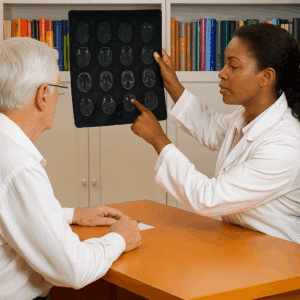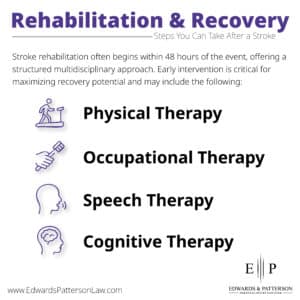
Hitting your head can indeed cause a stroke. In fact, can hitting your head cause a stroke? Traumatic brain injuries (TBIs) increase stroke risk. This article explains the link between head injuries and strokes, the types of strokes involved, risk factors, and how to prevent strokes after a head injury.
Key Takeaways
- Traumatic brain injury (TBI) significantly increases stroke risk, with individuals nearly twice as likely to experience a stroke compared to those without TBI.
- Both ischemic and hemorrhagic strokes can result from head injuries, stressing the importance of recognizing stroke symptoms post-injury for timely medical intervention.
- Preventative measures, including blood pressure monitoring, regular exercise, and effective stress management, are essential to reduce stroke risk following a head injury.

Brain Damage Attorney
Contact us today for your free & confidential case review. Our team will help you get the compensation that you deserve.
The Connection Between Head Injury and Stroke
Traumatic brain injury (TBI) is recognized as an independent risk factor for stroke, significantly increasing the likelihood of stroke occurrence. In populations with traumatic injury, the adjusted hazard ratio for stroke risk is approximately 1.86 compared to those without TBI, indicating an increased risk of stroke. This means that individuals who suffer head injuries are nearly twice as likely to experience an increased risk of stroke compared to those who haven’t suffered such injuries.
One of the critical aspects of this connection is the long-term effects of stroke risk that persists for up to five years after a traumatic brain injury, especially during the first three months. Head trauma can disrupt the blood-brain barrier, allowing harmful substances to enter the brain and increasing stroke risk, particularly relevant in those with a skull fracture. This disruption can lead to inflammation and damage to blood vessels, creating a conducive environment for stroke development and brain trauma.
Importantly, stroke risk extends to all severity levels of head injuries, affecting patients who may not have had severe head injuries. Whether it’s a mild traumatic brain injury (mild TBI) or a severe traumatic brain injury, the risk remains elevated. This underscores the need for vigilance and proactive measures to protect brain health and reduce stroke risk following any head trauma.
How Head Injuries Lead to Stroke
When a traumatic brain injury occurs, it can lead to significant damage in cerebral blood vessels, causing serious complications like reduced blood flow and potential blood clot formation. The inflammation triggered by head injuries can exacerbate damage to blood vessels, further elevating the likelihood that an injury causes a stroke. This inflammatory response is a critical factor in the cascade of events that can lead to a stroke.
Another contributing factor is the presence of vasospasms, which are abnormal contractions of blood vessels, after a head injury. These vasospasms can result in reduced blood flow, increasing stroke risk. Additionally, following a head injury, the brain may experience hypoperfusion, a condition where there is inadequate blood flow to the brain tissues. This lack of proper blood flow can lead to ischemic conditions conducive to stroke, especially when the brain’s oxygen delivery is prolonged and inadequate.
Head trauma can also lead to hemorrhagic strokes due to uncontrolled high blood pressure or other vascular issues. Hemorrhagic strokes occur when a blood vessel in the brain ruptures, leading to bleeding and pressure on brain cells. This type of stroke is particularly dangerous and underscores the importance of managing blood pressure and other vascular health factors following a head injury.
Types of Strokes Linked to Head Injuries

Hemorrhagic strokes, on the other hand, occur when a blood vessel in the brain ruptures, leading to bleeding and pressure on brain cells. This type of stroke can be caused by high blood pressure or vascular abnormalities resulting from the head injury, which are common causes of this type of stroke.
Both types of strokes, ischemic stroke and hemorrhagic stroke, can manifest as a result of traumatic brain injuries. Understanding these types and their link to head injuries is crucial for early intervention and prevention.
Contact us today for your free & confidential case review. Our team will help you get the compensation that you deserve.
Risk Factors for Stroke After a Head Injury
The severity of the head injury is a significant factor, with more severe injuries leading to a higher likelihood of stroke occurrences. However, it’s important to note that certain types of traumatic brain injuries (TBIs) are associated with increased stroke risk, regardless of their severity. This means that even mild TBIs can elevate the risk of stroke, making it essential to monitor and manage health post-injury.
Individuals who have experienced fall-related TBIs face a higher risk of stroke in the years following the injury. Key factors that increase stroke risk after a TBI include:
- Insomnia following a TBI can double the risk of stroke.
- High blood pressure resulting from head injuries significantly raises stroke risk.
- Chronic stress, which can increase stroke risk fourfold after a head injury, highlights the need for effective stress management strategies. Falls can also contribute to these complications.
Emerging post-traumatic stress disorder (PTSD) after a head injury has been linked to a higher likelihood of stroke and other complications. Cognitive impairments that arise after a traumatic brain injury are associated with an increased incidence of stroke. Physiological factors contributing to higher stroke risk post-head trauma include:
- Inflammation
- Disruption of blood flow
- Blood vessel damage
Understanding these risk factors can help in developing targeted prevention and intervention strategies.
Recognizing Stroke Symptoms Post-Head Injury
Recognizing stroke symptoms after a head injury is crucial for timely intervention. Numbness or weakness, particularly on one side of the body, is a key stroke symptom. Visual problems, such as sudden blurriness or loss of vision, can also signal a stroke. These symptoms may appear suddenly and can be easily overlooked if one is not vigilant.
A sudden, severe headache without a known common cause may be associated with some strokes. Loss of balance or coordination can be indicative of a stroke event. Additionally, sudden confusion, difficulty in speaking, or understanding may indicate a stroke. These symptoms, especially when occurring together, with similar symptoms, necessitate immediate medical attention for headaches.
The higher incidence of stroke is particularly notable within the first three months after a traumatic brain injury. Given that traumatic brain injury can independently elevate the risk of stroke, irrespective of the injury’s severity or type, it is vital to be aware of these warning signs. Time is critical; immediate medical attention is vital upon noticing stroke symptoms.
Preventing Stroke After a Head Injury
Preventing stroke after a head injury involves implementing lifestyle changes and medical interventions to reduce stroke risk. Preventive measures can significantly lower the overall stroke risk.
This comprehensive approach includes monitoring blood pressure, engaging in regular exercise, and managing stress effectively.
Monitoring Blood Pressure
High blood pressure is recognized as a major risk factor for stroke. Regular monitoring of blood pressure is essential since high blood pressure can significantly increase the likelihood of a stroke. Controlling blood pressure can substantially reduce stroke risk following a head injury.
Working with healthcare professionals to develop a blood pressure management treatment plan is essential. This may include lifestyle changes, medication, and regular check-ups.
Keeping blood pressure at optimal levels is vital for stroke prevention and long-term brain health.
Regular Exercise
Moderate-intensity aerobic activities for at least 150 minutes per week can significantly reduce stroke likelihood. Regular physical activity is crucial for overall health and particularly beneficial for stroke prevention in TBI patients.
Exercise improves blood flow, reduces blood pressure, and aids weight management, all essential for lowering stroke risk. Choose safe activities suitable for your condition and consult a healthcare provider before starting any new exercise regimen.
Stress Management
Relaxation techniques like deep breathing can manage stress levels and reduce stroke risk. Managing stress is crucial post-head injury, as chronic stress can heighten stroke risk. Mindfulness practices are also effective for stress management after a brain injury.
If meditation for stress management proves challenging, consult your doctor about helpful medications. Managing stress is integral to recovery and can significantly enhance brain health and overall well-being.
Therapists help stroke patients adapt by:
- Using unaffected limbs for daily tasks
- Applying motor learning principles such as spaced practice and varied feedback, which are essential for effective rehabilitation
- Supporting patients to achieve functional independence in daily activities, which often takes up to 6 months post-stroke for many patients
Task-oriented training that mirrors real-life activities can boost motivation and improve recovery outcomes. Innovative approaches include new research on research:
- Robotic devices, which offer intensive practice opportunities and aid rehabilitation
- Virtual reality provides immersive and engaging rehabilitation experiences
- Electrical stimulation, which can enhance muscle activation and movement in stroke recovery
Contact us today for your free & confidential case review. Our team will help you get the compensation that you deserve.
Legal Considerations for Head Injury-Induced Strokes
Liability for a stroke following a head injury depends on who caused the accident, such as a negligent driver, employer, or manufacturer. In negligence cases, liability may fall on drivers, employers, or property owners. If unsure who is responsible for your head injury, contact an attorney to explore your claim options.
Claims for damages must be initiated within three years of the injury, with an extended limit for minors. Legal representation is crucial for navigating head injury-induced stroke claims to ensure proper compensation, providing essential support for care and rehabilitation needs.
Frequently Asked Questions
Can a mild traumatic brain injury cause a stroke?
Yes, a mild traumatic brain injury can increase the risk of stroke. It’s important to be aware of this potential complication following any head injury.
What are the main types of strokes linked to head injuries?
The main types of strokes linked to head injuries are ischemic and hemorrhagic strokes. Both types can result from damage to blood vessels in the brain.
What are the key symptoms of a stroke after a head injury?
The key symptoms of a stroke after a head injury include numbness, visual disturbances, severe headache, loss of balance, and confusion. Recognizing these signs promptly is crucial for effective treatment.
How can I prevent a stroke after a head injury?
To prevent stroke after a head injury, it’s essential to monitor blood pressure, engage in regular exercise, and manage stress effectively. These steps can significantly reduce your risk.
What should I do if I suspect a stroke after a head injury?
If you suspect a stroke after a head injury, seek immediate medical attention, as timely intervention is critical for the best outcomes.
Related Articles
Maximize Your Compensation in a Traumatic Brain Injury Lawsuit
How Long Does It Take to Settle a Brain Injury Case? Insights & Timeline
Last updated Tuesday, July 8th, 2025













